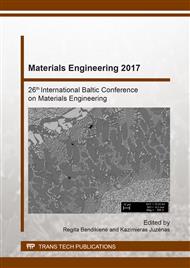[1]
A. Polman, M. Knight, E.C. Garnett, B. Ehler, W.C. Sinke, Photovoltaic materials: Present efficiencies and future challenges, Science 352 (2016) aad4424-1 – aad4424-10.
DOI: 10.1126/science.aad4424
Google Scholar
[2]
A. Blakers, N. Zin, K.R. McIntosh, K. Fong, High efficiency silicon solar cells, Energy Procedia 33 (2013) 1-10.
DOI: 10.1016/j.egypro.2013.05.033
Google Scholar
[3]
J. Le Perchec, A. Lanterne, T. Michel, S. Gall, R. Monna, F. Torregrosa, L. Roux, 19. 3 % Efficiency on p-type silicon solar cells by pulsion® plasma-immersion implantation, Energy Procedia 33 (2013) 18-23.
DOI: 10.1016/j.egypro.2013.05.035
Google Scholar
[4]
T.P. White, N.N. Lal, K.R. Catchpole, Tandem solar cells based on high-efficiency c-Si bottom cells: top cell requirements for >30% Efficiency, IEEE Journal of Photovoltaics 4 (2014) 208-214.
DOI: 10.1109/jphotov.2013.2283342
Google Scholar
[5]
C. Battaglia, A. Cuevas, S. De Wolf, High-efficiency crystalline silicon solar cells: status and perspectives, Energy Environ. Sci. 9 (2016) 1552-1576.
DOI: 10.1039/c5ee03380b
Google Scholar
[6]
M.A. Green, K. Emery, Y. Hishikawa, W. Warta, E.D. Dunlop, D.H. Levi, A.W.Y. Ho-Baillie, Solar cell efficiency tables (version 49), Prog. Photovolt: Res. Appl. 25 (2017) 3-13.
DOI: 10.1002/pip.2855
Google Scholar
[7]
S. Ašmontas, J. Gradauskas, A. Sužiedelis, A. Šilėnas, E. Širmulis, V. Vaičikauskas, V. Vaičiūnas, O. Žalys, L. Fedorenko, L. Bulat, Photovoltage formation across GaAs p-n junction under illumination of intense laser radiation, Optical and Quantum Electronics 48 (2016).
DOI: 10.1007/s11082-016-0702-z
Google Scholar
[8]
J. Gradauskas, E. Širmulis, S. Ašmontas, A. Sužiedėlis, Z. Dashevsky, V. Kasiyan, Peculiarities of high power infrared detection on narrow-gap semiconductor p-n junctions, Acta Phys. Pol. A 119 (2011) 237-240.
DOI: 10.12693/aphyspola.119.237
Google Scholar
[9]
R.T. Ross, A.J. Nozik, Efficiency of hot carrier solar energy converters, J. Appl. Phys. 53 (1982) 3813-3818.
DOI: 10.1063/1.331124
Google Scholar
[10]
L.C. Hirst, N.J. Ekins-Daukes, Fundamental losses in solar cells, Prog. Photovolt: Res. Appl. 19 (2011) 286-293.
DOI: 10.1002/pip.1024
Google Scholar
[11]
J. Rodiere, L. Lombez, A. Le Corre, O. Durand, J.F. Guillemoles, Experimental evidence of hot carriers solar cell operation in multi-quantum wells heterostructures, Appl. Phys Lett. 106 (2015) 183901-1 – 183901-4.
DOI: 10.1063/1.4919901
Google Scholar
[12]
D.E. Aspnes, A.A. Studna, Dielectric functions and optical parameters of Si, Ge, GaP, GaAs, GaSb, InP, InAs and InSb from 1. 5 to 6. 0 eV, Phys. Rev. B 27 (1983) 985-1009.
DOI: 10.1103/physrevb.27.985
Google Scholar
[13]
J. Nelson, The physics of solar cells, London Imperial College Press, London, (2006).
Google Scholar
[14]
S. Ašmontas, J. Gradauskas, D. Seliuta, E. Širmulis, Photoelectric properties of nonuniform semiconductors under infrared laser radiation, Proc. SPIE 4423 Nonresonant Laser-Matter Interaction (NLMI-10, M.N. Libenson, Ed. ) (2001) 18-27.
DOI: 10.1117/12.431223
Google Scholar
[15]
A.D. Bristow, N. Rotenberg, H. M van Driel, Two-photon absorption and Kerr coeffcients of silicon for 850-2200 nm, Appl. Phys. Lett. 90 (2007) 191104-1 – 191104-3.
DOI: 10.1063/1.2737359
Google Scholar
[16]
W. Spitzer, M.Y. Fan, Infrared absorption in n-type silicon, Phys. Rev. 108 (1957) 268-271.
Google Scholar
[17]
A. Dargys, J. Kundrotas, Handbook on physical properties of Ge, Si, GaAs and InP, Science and Encyclopedia Publishers, Vilnius, (1994).
Google Scholar


